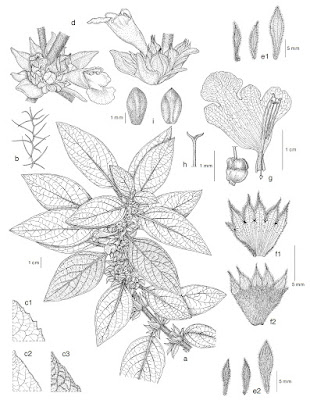[Most Recent Entries] [Calendar View]
Sunday, April 21st, 2024
| Time | Event | ||
| 6:02a | [Botany • 2024] Gladiolus oreophilus (Iridaceae: Crocoideae) • A New Species from southern Anatolia, Turkey
Gladiolus oreophilus Eker & Sağıroğlu sp. nova (Iridaceae) is described as a new species from the Hatay Province, Turkey. It resembles G. kotschyanus, G. alanyensis and G. adanus, but it clearly differs from these three species by capsule size, flower colour, number and width of leaves, seed shape and ornamentation, and shapes of periclinal cell walls and testa epidermal cells. Herein, we provide the morphological features, distribution, habitat characteristics, conservation assessment, and micromorphological characteristics of seeds of G. oreophilus. Sağıroğlu M. & Eker İ. 2024. Gladiolus oreophilus (Iridaceae, Crocoideae), A New Species from southern Anatolia, Turkey. — Ann. Bot. Fennici. 61: 111–117. | ||
| 2:08p | [Ichthyology • 2024] Careproctus io • A New Snailfish (Scorpaeniformes: Liparidae) from the Western North Pacific, with Comments on Generic Limits
Abstract The new snailfish Careproctus io is described on the basis of three specimens collected from the western North Pacific, off northeastern Honshu Island, Japan. The new species can be distinguished from congeners by the following characters: vertebrae 40–42; dorsal-fin rays 36 or 37; anal-fin rays 30; pectoral fin deeply notched with 28 or 29 rays, lower lobe reaching to anal-fin origin; large pelvic disk 34.2%–34.5% HL (10.3%–10.9% SL); teeth strongly trilobed on both jaws, inner teeth weakly trilobed or shouldered; cephalic pore pattern 2-6-7-2, chin pores paired; gill slit above pectoral-fin base; body bright red, non-variegated in life. Species of Careproctus Krøyer, 1862 typically have fewer pectoral-fin rays than anal-fin rays, although some recently-described species, including the present new species, have similar ray counts in both fins. The relationships between such counts, as well as pelvic disk size, are investigated for various snailfish, genera, and the generic limits of Careproctus discussed. Keywords: Actinopterygii, Scorpaeniformes, Careproctus, COI, pelvic disk size
Careproctus io sp. nov. [New standard Japanese name: Mini-kon’nyakuuo] Diagnosis. A species of Careproctus with the following combination of characters: vertebrae 40–42; dorsal-fin rays 36 or 37; anal-fin rays 30; pectoral fin with 28 or 29 rays, deeply notched, lower lobe reaching to anal-fin origin; large pelvic disk 34.2%–34.5% HL (10.3%–10.9% SL); teeth strongly trilobed on both jaws, inner teeth weakly trilobed or shouldered; cephalic pore pattern 2-6-7-2, chin pores paired; gill slit above pectoral-fin base; body bright red, non-variegated in life. Etymology. The specific name is a noun in apposition after Io, a Greek mythological character who wandered the world without rest, due to the unsettled phylogenetic position of the new species (see under Remarks). The standard Japanese name “Mini” reflects its small body size. Yoshiaki Kai, Eisuke Morikawa and Ryo Misawa. 2024. Careproctus io (Teleostei: Liparidae), a New Snailfish from the Western North Pacific, with Comments on Generic Limits. Species Diversity. 29(1); 111-117. DOI: 10.12782/specdiv.29.111 | ||
| 2:45p | [Botany • 2022] Gomphostemma phetchaburiense (Lamiaceae) • A New Species from A Limestone Karst in southwest Thailand
Abstract Gomphostemma phetchaburiense, a new species from Phetchaburi Province, Thailand, is described and illustrated. A key to the species of Gomphostemma in Thailand is provided and conservation status and the dimorphic leaf characters are discussed. Keywords: Gomphostemma; Lamiaceae; Primulina; convective heat; leaf serration; limestone Bhanubong Bongcheewin, Manop Poopath and Alan J. Paton. 2022. Gomphostemma phetchaburiense (Lamiaceae), A New Species from A Limestone Karst in southwest Thailand. Blumea - Biodiversity, Evolution and Biogeography of Plants. DOI: 10.3767/blumea.2022.67.01.07 | ||
| 2:52p | [Botany • 2024] Camellia zijinica (Theaceae) • A New Species endemic to Danxia Landscape from Guangdong Province, China
Abstract A new species of the genus Camellia (Theaceae), Camellia zijinica, discovered in the Danxia landscape from Guangdong Province, China, is characterized and illustrated. Phylogenetic analysis based on chloroplast genomes suggested its affinity with C. drupifera, C. oleifera and C. fluviatilis, however, it morphologically differs from all of the latter by leaf shape and size. Phonologically, it most closely resembles C. microphylla, but can be distinguished from the latter by its young branchlets glabrous (vs. densely pubescent), fewer bracteoles and sepals, diverse leaf shape, midvein raised slightly with sparsely pubescent or glabrous (vs. prominently with densely pubescent) and leaf adaxially matt (vs. vernicose) when dried. By morphological and molecular analyses, Camellia zijinica represented a distinct new species of C. sect. Paracamellia. Key words: Camellia, Danxia landscape, morphology, new species, phylogeny Camellia zijinica M.Lin, Q.L.Ye & Q.Fan, sp. nov. Chinese name: 紫金短柱茶 Etymology: The specific epithet refers to Zijin County of Guangdong Province, the type locality of the new species. Min Lin, Qin-Liang Ye, Zhi-Jian Zhang, Wen-Bo Liao and Qiang Fan. 2024. Camellia zijinica (Theaceae), A New Species endemic to Danxia Landscape from Guangdong Province, China. PhytoKeys. 237: 245-255. DOI: 10.3897/phytokeys.237.114768 |
| << Previous Day |
2024/04/21 [Calendar] |
Next Day >> |












